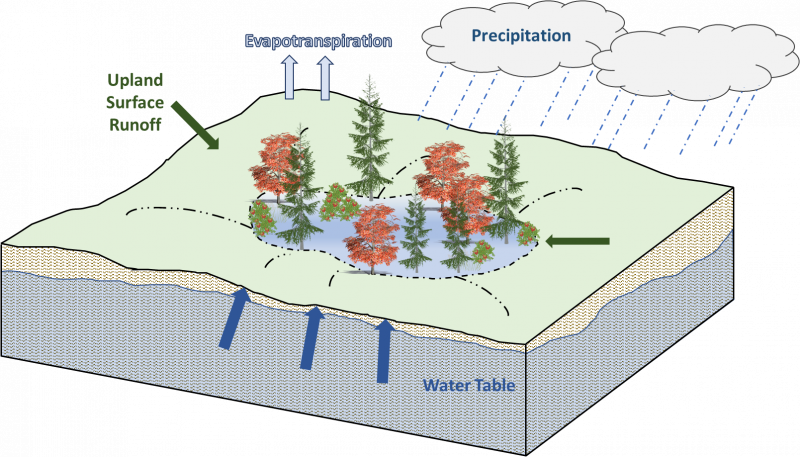
Natural Resources
Conservation Service
Ecological site R110XY020IL
Ponded Organic Acidic Peatland
Last updated: 4/22/2020
Accessed: 12/21/2025
General information
Provisional. A provisional ecological site description has undergone quality control and quality assurance review. It contains a working state and transition model and enough information to identify the ecological site.
MLRA notes
Major Land Resource Area (MLRA): 110X–Northern Illinois and Indiana Heavy Till Plain
The Northern Illinois and Indiana Heavy Till Plain (MLRA 110) encompasses the Northeastern Morainal, Grand Prairie, and Southern Lake Michigan Coastal landscapes (Schwegman et al. 1973, WDNR 2015). It spans three states – Illinois (79 percent), Indiana (10 percent), and Wisconsin (11 percent) – comprising about 7,535 square miles (Figure 1). The elevation is about 650 feet above sea level (ASL) and increases gradually from Lake Michigan south. Local relief varies from 10 to 25 feet. Silurian age fractured dolomite and limestone bedrock underlie the region. Glacial drift covers the surface area of the MLRA, and till, outwash, lacustrine deposits, loess or other silty material, and organic deposits are common (USDA-NRCS 2006).
The vegetation in the MLRA has undergone drastic changes over time. At the end of the last glacial episode – the Wisconsinan glaciation – the evolution of vegetation began with the development of tundra habitats, followed by a phase of spruce and fir forests, and eventually spruce-pine forests. Not until approximately 9,000 years ago did the climate undergo a warming trend which prompted the development of deciduous forests dominated by oak and hickory. As the climate continued to warm and dry, prairies began to develop approximately 8,300 years ago. Another shift in climate that resulted in an increase in moisture prompted the emergence of savanna-like habitats from 8,000 to 5,000 years before present (Taft et al. 2009). Forests maintained footholds on steep valley sides, morainal ridges, and wet floodplains. Fire, droughts, and grazing by native mammals helped to maintain the prairies and savannas until the arrival of European settlers, and the forests were maintained by droughts, wind, lightning, and occasional fire (Taft et al. 2009; NatureServe 2018).
Classification relationships
USFS Subregions: Southwestern Great Lakes Morainal (222K) and Central Till Plains and Grand Prairies (251D) Sections; Kenosha-Lake Michigan Plain and Moraines (222Kg), Valparaiso Moraine (Kj), and Eastern Grand Prairie (251Dd) Subsections (Cleland et al. 2007)
U.S. EPA Level IV Ecoregion: Kettle Moraines (53b), Illinois/Indiana Prairies (54a), and Valparaiso-Wheaton Morainal Complex (54f) (USEPA 2013)
National Vegetation Classification – Ecological Systems: Laurentian-Acadian Alkaline Conifer-Hardwood Swamp (CES201.575) (NatureServe 2018)
National Vegetation Classification – Plant Associations: Larix laricina – Thuja occidentalis Swamp Forest (CEGL002455) (Nature Serve 2018)
Biophysical Settings: Laurentian-Acadian Swamp Systems (BpS 6314810) (LANDFIRE 2009)
Illinois Natural Areas Inventory: Graminoid bog, Low shrub bog, Forested bog (White and Madany 1978)
Wisconsin Natural Communities: Southern tamarack swamp, Poor fen (WDNR 2015)
Ecological site concept
Ponded Organic Acidic Peatlands are located within the green areas on the map. They occur on depressions of lake plains or outwash plains. The soils are Histosols that are very poorly drained and very deep, formed in organic material.
The historic pre-European settlement vegetation on this ecological site was dominated by hydrophytic woody and herbaceous species and mosses. Tamarack (Larix laricina (Du Roi) K. Koch) is the canopy dominant with several common canopy associates including red maple (Acer rubrum L.), black ash (Fraxinus nigra Marshall), green ash (Fraxinus pennsylvanica Marshall), and paper birch (Betula papyrifera Marshall). Shrubs can be well developed and dense with species such as, bog birch (Betula pumila L.), cranberry (Vaccinium macrocarpon Aiton), poison sumac (Toxocodendron vernix (L.) Kuntze) and redosier dogwood (Cornus sericea L. ssp. sericea). Sphagnum (Sphagnum L.) mosses can form a dense understory layer that support a unique community of acidophilic species (White and Madany 1978; WDNR 2015). Common winterberry (Ilex verticillate (L.) A. Gray) is a highly conservative species of the site that is indicative of an undisturbed plant community (White and Madany 1978; Taft et al. 1997). Water level fluctuations are the primary disturbance factor that maintain the site, while drought, occasional fire, and windthrow are secondary disturbances (LANDFIRE 2009; WDNR 2015).
Associated sites
| R110XY008IL |
Wet Glacial Drift Upland Prairie Loess or other silty or loamy material, loamy outwash, glacial till, lacustrine deposits, and colluvium that are shallow to a high-water table including Ashkum, Bryce, Drummer, Dunham, Elpaso, Matherton, Milford, Monee, Montgomery, Pella, Reddick, Rowe, Selma, Selmass, Westland, and Will soils |
|---|
Similar sites
| R110XY021IL |
Ponded Organic Alkaline Peatland Ponded Organic Alkaline Peatland is a SLOPE wetland |
|---|
Table 1. Dominant plant species
| Tree |
(1) Larix laricina |
|---|---|
| Shrub |
(1) Betula pumila |
| Herbaceous |
(1) Sphagnum |
Click on box and path labels to scroll to the respective text.



